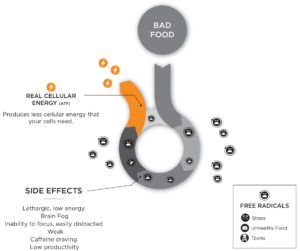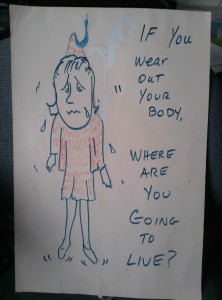Dear Ones,
I’ve been unpacking the challenges we face when we try to change our lifestyle. We want to achieve certain health goals. What prevents us from making those changes?
It isn’t easy. I talk about these challenges is on www.fb.com/betsybellshealth4u live steam at 8:30 Thursdays, Pacific time. In case you are not a FaceBook person, here are the first two videos unpacking challenges to life-style changes.
In the first live stream, I talk about my own struggle with sudden weight gain and the ineffective, in fact, detrimental steps I took to get the weight off. A good friend is approaching sixty and complaining of aches and pains, higher cholesterole and persistent belly fat. He called me to see if I had a pill for any of that. Here’s what I had to say.
To better understand how our cells metabolise the food we eat, I gave this short talk on the Krebs cycle, the process by which the food we eat is used to produce energy.
In plain English the process involves the interaction of the food that we consume and the biochemical processes within the body. These interactions produce energy that our body uses to do its work. The Krebs cycle is at the center of the many processes at work in the cell.
Knowing how this cycle works, we can change our diet, and change our behavior or activity to maximize results. The Krebs cycle is closely tied to our diet, and is directly involved in the metabolism of carbohydrates and fats and its conversion to energy. Understanding what is going on in the body may help you with your eating and exercise –lifestyle–decisions, and help you to better control your body metabolism.

Focus on the 3 major sources of substrates or fuel molecules, carbohydrates, fats, and protein. Here we go:
What is the Kreb’s Cycle?
*This is the biochemical hub of the cell.
*It is thru this cycle that energy precursors are converted into ATP (Adenosine Triphosphate), which is the then processed to produce the energy that the body utilizes.
*This pathway is the final common pathway for the oxidation of fuel molecules, namely – amino acids, fatty acids, and carbohydrates.
*These molecules undergo processing and enter the cycle in the form of acetyl-coenzyme A.
Normally during aerobic conditions (or states wherein oxygen is available for utilization by the body), the body converts carbohydrates into glucose which is processed to form acetyl-CoA.
*The Krebs cycle allows the harvesting of high-energy electrons from fuels that we take in.
*The Krebs cycle forms the first stage of the cellular level of respiration. In this process, acetyl-CoA, coming from multiple sources (glucose, fat, and protein metabolism) is processed to produce ATP (Adenosine Triphosphate) which is the primary resource of most energy consuming processes in the body.
*The Krebs cycle is closely related to other metabolic cycles and can explain how we utilize energy substrates we derived from our diet.
*Fatty acids and amino acids can both be converted to materials that the cells utilize as sources of energy.
*Most of the time, the body utilizes glucose, but in specific conditions, the body turns to other sources.
*Fatty acids, coming from fat, are shuttled into the metabolic pathways, and conditions that have high energy requirements tap into fat stores in the body for extra energy to perform the exercises or movements we want to complete at that time. Using fat energy is much faster than our typical glucose utilization.
This is good news. It is through this mechanism that we burn off the excess fat in our body. However fat did not create the excess fat in your body in the first place. It’s far more likely that excess sugar in your diet contributed to your fat gain. This is because your liver can’t keep up with all that sugar and eventually turns to storing it as fat as a means to deal with it.
Have you been eating low- fat, no-fat, processed foods, with loads of added sugar (so they taste good) for years to lose weight and had little or no success? These foods are the real culprits as to why you are fat. They have next to no nutritional value. All calories are no created equal. If that were the case you could eat 200 calories from sugar and 200 cals from protein and you’d get the same result. The problem being, you DO NOT get the same result.
The Metabolic Pathways Involving The Krebs Cycle
Glucose plays a major role in the generation of energy via the Krebs cycle. Other materials may be used to produce energy: fatty acids and amino acids. Fatty acids come from fat, and amino acids are the building blocks of protein. Though they all end up in a common path in the Krebs cycle, they are being processed by different mechanisms in the body.
Glucose metabolism undergoes processing by way of glycolysis. The end product — pyruvate is converted to Acetyl-CoA, that then goes into the Krebs cycle. Fatty acids are broken down via Beta-oxidation,which forms acyl-CoA, and is then processed into Acetyl-CoA.
Amino acids follow a different process. Protein is broken down and later on forms amino acids, which undergo transamination. In their new form, these amino acids are storaged as fat or glycogen, are made into new protein in the body, or are oxidized for energy.
The body utilizes these different pathways to provide you with adequate energy for every scenario and state possible. Knowing about these pathways and states helps us tailor our diet and physical activity to maximize our health benefits.
Exercise and Energy Metabolism
Now, under normal conditions, wherein we don’t exercise, and are just doing normal daily activities, we utilize materials coming from the metabolism of glucose from our diet. Anything in excess is converted into energy stores. Anything we eat that is beyond our energy requirement is stored by the body in different forms, primarily fa. That fat will remain as such until our body enters a state of high energy requirement (e.g. increased physical activity).
We limit the intake of glucose or carbohydrates to an amount that matches our caloric requirement, hence preventing the accumulation of fat stores. Also pay attention to the sugar you are getting daily.
Pay attention to the balance between carbohydrates (fresh fruits and vegetables or processed goodies), fat (dairy of all kinds and fatty meats, sausage, lunch meat, cheese) and protein (animal protein or plant protein which can get tricky). It all becomes glucose eventually.
Know how our body utilizes glucose for energy and how it turns to stored fats as extra sources of energy when we exercise. Then change the process through changing the fuel. Exercise uses our fat stores for extra energy, resulting in weight loss and less fat in the body.
I hope this is helpful and makes sense. Don’t try to memorize this. There is no quiz. Just use the information so that when you are putting something in your mouth you take note: will this bite become glucose quickly leaving the roll around my middle just where it is? Or will this bite require work to produce energy and therefore reach for to burn fat? Munch a carrot. Eat nuts. Have a bowl of rice and beans. Calories are not all the same. Keep the amount of calories equal to the energy required for your day’s activities.
Questions?
Above all, be well, do well and keep moving,
Betsy
And if you want to get a good start toward a new lifestyle, take advantage of the Shaklee Cleanse package. If you follow it to the letter, you will see results. If you’re like me and grow faint without protein, order a cannister of one of Shaklee’s sugar free shake mixes and add just a little to keep you on your feet during this week of vegetables and fruits.
www.HiHoHealth.com My Shaklee shopping site.
